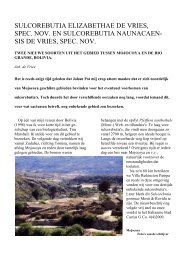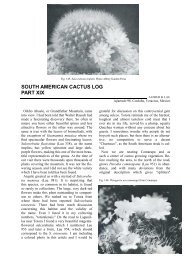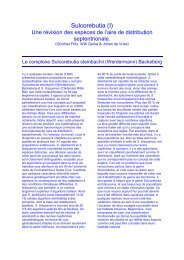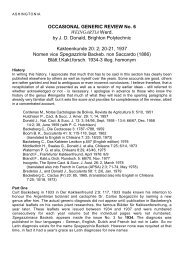Sulcorebutia, food for taxonomists?
Sulcorebutia, food for taxonomists?
Sulcorebutia, food for taxonomists?
You also want an ePaper? Increase the reach of your titles
YUMPU automatically turns print PDFs into web optimized ePapers that Google loves.
the weingartias and the sulcorebutias, but not the aylosteras and mediolobivias. It struck me<br />
that he showed only a part of the clad gram of Dr.Ritz, from which the browningias had been<br />
removed.<br />
I don’t know the algorithm behind this clad gram. But in the cladograms prepared by me the<br />
position of every individual is determined by the presence of all other individuals. If a plant is<br />
removed, different arithmetical averages will be found and there<strong>for</strong>e the position of some of<br />
the plants may change. For the record: the vertical distances in these cladograms have no<br />
other purpose than to keep the diagram legible. Thus they have nothing to do with the<br />
closeness of the relationship.<br />
Ritz stated, that her project confirmed the observation of the branched funicles by Hentzschel.<br />
The same goes <strong>for</strong> the hairless pericarps of Weingartia, <strong>Sulcorebutia</strong> and Rebutia. Obviously<br />
the error of Hentzschel had not been discovered and Brederoo and Donald seemed to have<br />
done careless observations.<br />
In my opinion a spicy detail is the names used <strong>for</strong> species, which would correspond to those<br />
in „Das große Kakteenlexikon“ of Anderson in the case of the rebutias and the sulcorebutias<br />
and to „Die Gattung Weingartia“ of Augustin and Hentzschel in the case of weingartias.<br />
It is reassuring to see that in the clad gram<br />
all canigueralii’s, all neocumingii’s and all<br />
steinbachii’s are close together. The<br />
position of S. cardenasiana did surprise<br />
me.<br />
In the upper part you find a S. spec. (Fig.<br />
16). This might be a very interesting plant,<br />
not only because it is not well known and<br />
wanted. Though it has been discovered at<br />
the same latitude as S. tarijensis, it reminds<br />
one very much of S. cardenasiana. (Fig.<br />
17) Suppose – which I do not suspect of<br />
course – that some error did creep in. In<br />
that case S. cardenasiana would occur<br />
in two different clades. This I would<br />
consider very questionable.<br />
West European amateurs of the continent<br />
prefer to keep old, established names, even<br />
if they are not quite correct. It was a relief<br />
that the „cardenasiana“ mentioned in the<br />
clad gram is called S. langeri every time in<br />
the known collections.<br />
Some amateurs wondered why Ritz did not<br />
immediately recombine all sulcorebutias to<br />
Weingartia. I imagine it was not her<br />
intention at all. Ritz is a geneticist. A<br />
geneticist is not by definition a taxonomist.<br />
Fig. 16. <strong>Sulcorebutia</strong> spec.<br />
Fig. 17. <strong>Sulcorebutia</strong> cardenasiana HS 41<br />
By the way, it is not known to me if taxonomist is a recognized profession with a protected<br />
status. Possibly everybody is allowed to call him- or herself a taxonomist.<br />
Günter Hentzschel and Karl Augustin (2008) published the second part of „Die Gattung<br />
Weingartia“. They concluded that morphologically no fundamental differences existed<br />
between Weingartia, <strong>Sulcorebutia</strong> and Cynthia concerning body, flower and fruit. Also they<br />
had made several attempts to hybridise, between these genera, the results of which could be







